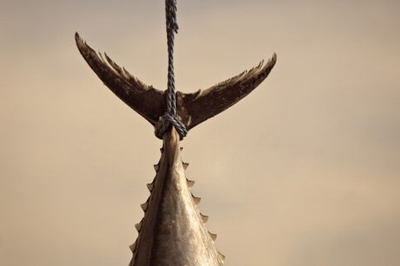
The news announced by NOAA Fisheries earlier this week was enough to make us turn seasick-green. Atlantic bluefin tuna—a species so coveted it has its own reality TV show and prompts hand-wringing of environmentalists everywhere—is being tossed overboard, dead, at a nauseating rate by American surface longline fishermen.
How bad it is? Nearly 25 percent of our nation’s quota—allotted to the U.S. by the International Commission for the Conservation of Atlantic Tunas (ICCAT)—ends up discarded. In all, it’s an estimated 239.5 metric tons of bluefin tuna that will never, ever hit a sushi bar near you.
While much of the discards (129 metric tons) occur off the Atlantic coast, the rest (110 metric tons) is happening in the Gulf of Mexico by longline fishermen who go after swordfish and yellowfin. While that number is slightly smaller, it’s also far more troubling. As environmental writer Andy Revkin points out, the Gulf of Mexico is “the western population’s only known spawning area.”
“I’ve been hearing people today saying they’re shocked,” Carl Safina, ocean scientist and president of Blue Ocean Institute, tells TakePart. “I’m not even surprised. It’s what you get when you don’t take a serious problem seriously.”
“The longline fishery has been the subject of controversy, rule making and endless discussion for 30 years—practically the entire working lifetime of many fishermen,” he says. “It’s time that it gets fixed once and for all. There’s an option that exists, and that’s what fishermen should be required to do.”
That solution, says Safina, is to convert the fishery to lures, instead of the miles upon miles (we’re talking some 40 miles) of baited hooks currently being used.
“You can catch swordfish and yellowfin by trolling on the surface with different lures which the giant bluefin tend not to like,” says Safina.
Brad McHale, fishery management specialist at NOAA Fisheries, says that’s one option being considered.
The 2012 bluefin discard figure, which is the highest since 1987, has prompted the agency to prohibit longline fishermen from keeping—and thus profiting from—any further bluefin as “incidental catch” starting June 25.
“But they’re still going to be allowed to continue to fish for swordfish and yellowfin,” says Pew’s Tom Wheatley, manager, U.S. Oceans. That means those accidental catches of bluefin will continue to happen. The only difference? The longline fishery won’t be allowed to keep any.
“The longliners were the only ones that can keep some bluefin. It’s essentially a loophole we want to see stopped,” says Wheatley.
That’s imperative, says Wheatley, because allowing accidental catch of financially lucrative bluefin diminishes any incentive to not catch them.
McHale thinks that incentive imbalance is exaggerated.
“The value of bluefin is actually in the fresh fish caught and landed the same day and exported to the Japanese sushi market. With longlining, these vessels do trips that can be a week or two in duration, so the value of the bluefin they land isn’t what you’d hear for the same pricing on a dayboat-caught fish.”
Solutions that would require changes to fishing gear, or prohibiting all accidental landings, aren’t the only options NOAA is considering as they draft new bluefin tuna regulations, which are expected to be released by the agency in mid- to late-July. Also under consideration? Restricting the months and geographic areas in which longline fishing can occur at all.
“In that amendment, we’re thinking of closing the entire fishery—meaning they can’t use longline gear at all, once the bluefin quote is met,” McHale tells TakePart.
Whatever recommendations the agency finally comes out with later this summer, expect debate during the public comment period to get heated.





